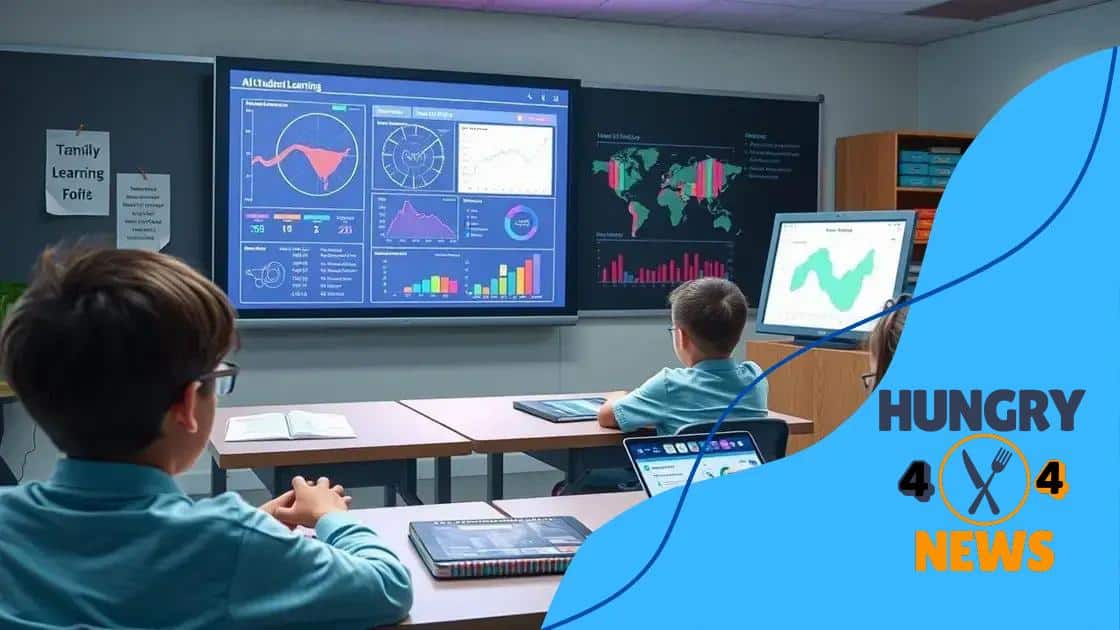AI tools to monitor and enhance student engagement

AI tools for monitoring and enhancing student engagement personalizes learning, promotes interactive experiences like gamification and virtual reality, and leverages predictive analytics to support student performance and retention.
AI tools to monitor and enhance student engagement have become essential in today’s educational landscape. They not only help teachers understand student behavior but also create a more dynamic learning environment. Curious about how these tools can transform classrooms?
Understanding student engagement and its importance
Understanding student engagement is crucial for creating an effective learning environment. When students are actively engaged, they show interest in their studies and participate more in class activities. This not only boosts their performance but also enhances their overall learning experience.
The Role of Engagement in Learning
Student engagement plays a vital role in academic success. Engaged students are more likely to attend classes regularly and complete assignments on time. They also tend to achieve higher grades and develop important skills necessary for their future careers.
Benefits of Highly Engaged Students
- Improved academic performance
- Increased retention rates
- Enhanced critical thinking skills
- Greater motivation and enthusiasm for learning
When educators focus on enhancing engagement, they create a positive classroom atmosphere. For instance, using interactive learning activities such as group projects or discussions can significantly increase student interest. Additionally, integrating technology, like AI tools, helps personalize learning and meets students’ diverse needs.
Moreover, understanding what engages students allows teachers to adjust their methods. By observing which subjects ignite passion, teachers can tailor their lessons accordingly. Regularly seeking feedback from students about their interests can further enhance engagement strategies.
In summary, understanding student engagement is not just about keeping students occupied; it involves fostering a connection that promotes deeper learning. In the next sections, we’ll explore how AI tools can specifically monitor and enhance this engagement.
Top AI tools for monitoring student interaction
Many educators are now turning to AI tools to enhance their teaching methods. The right tools can significantly improve how teachers monitor student interaction. By leveraging technology, educators gain valuable insights into student behavior and engagement.
1. Learning Analytics Platforms
Learning analytics platforms use data to track how students engage with learning materials. These tools provide real-time insights into students’ progress and challenges. With this data, teachers can identify which students may need help.
- Monitor student participation in discussions
- Track assignment submissions and performance
- Analyze participation trends over time
Furthermore, these platforms often include dashboards that offer a user-friendly view of student activity. This allows teachers to make informed decisions quickly.
2. Engagement Monitoring Tools
Engagement monitoring tools focus specifically on how students interact with course content. They gather data on clicks, time spent on tasks, and even participation in polls or quizzes. These insights help educators understand if students are genuinely engaged.
3. Communication Platforms
Tools like forums and chat applications foster better communication between students and teachers. They provide a platform where teachers can ask questions and gather feedback on lessons. The data collected can help educators assess which topics resonate most with students.
By utilizing various AI tools, teachers can easily create a more engaging learning experience. From identifying struggling students to tailoring lessons based on feedback, these tools are essential in modern classrooms.
Ultimately, understanding how to effectively use these AI tools for monitoring student interaction enhances the overall educational experience.
How AI can personalize learning experiences

AI has the power to transform education by personalizing learning experiences for each student. This approach tailors instruction to meet individual needs, making learning more effective and engaging.
1. Adaptive Learning Technologies
One of the key ways AI personalizes learning is through adaptive learning technologies. These programs assess a student’s abilities and adjust the difficulty of tasks accordingly. This ensures that students are neither bored nor overwhelmed.
- Identifies the strengths and weaknesses of each student
- Adapts content based on real-time performance
- Provides customized learning paths
For instance, if a student excels in math but struggles with reading comprehension, an AI system can propose targeted exercises to improve those weak areas.
2. Intelligent Tutoring Systems
Intelligent tutoring systems utilize AI to offer one-on-one support. These systems analyze student interactions and provide instant feedback. They can help students navigate difficult concepts by presenting them in different ways until they understand.
This personalized support is vital, as it mimics the benefits of having a personal tutor, making learning more accessible. By using AI, educators can focus on facilitating learning while technology handles individual student progress.
3. Data-Driven Insights for Teachers
AI also provides valuable data-driven insights for teachers. By analyzing student performance, AI tools highlight areas where groups of students may be struggling. This allows teachers to adjust their lessons in real-time and provide the right resources for each student.
Moreover, AI can recommend supplemental materials that fit the learning style of individual students. Whether a student learns better through visual aids or hands-on activities, AI helps create a customized educational experience.
Evaluating the effectiveness of AI in education
Evaluating the effectiveness of AI in education is crucial for understanding how these tools impact student learning and engagement. Schools and educators need to measure outcomes to determine if these technologies are working as intended.
1. Setting Clear Objectives
To effectively evaluate AI tools, schools should first set clear objectives. This means defining what success looks like. Is it improved grades, increased engagement, or better retention of information? By establishing goals, educators can better assess whether AI tools are meeting their needs.
- Identify specific learning outcomes
- Determine metrics for measuring success
- Involve educators in the planning process
With these objectives in mind, teachers can then monitor the tools’ impact on classroom performance.
2. Collecting Data
Data collection is another vital step. Educators can use various methods such as surveys, test scores, and engagement analytics. By gathering this information, they can compare performance before and after introducing AI tools.
For example, tracking student participation in interactive lessons versus traditional lectures can provide insights into engagement levels. This data helps paint a clearer picture of how students are responding to AI interventions.
3. Analyzing Results
Once data is collected, it needs to be analyzed. This involves looking for trends and patterns that indicate whether AI is making a positive difference. Are students performing better? Are they more motivated? Teachers should also consider qualitative feedback from students about their experiences with AI tools.
Evaluations should be done regularly, not just at the end of the school year. This ongoing process allows for adjustments to be made as needed. By continuously assessing the effectiveness of AI in education, schools can ensure they are providing the best learning experience possible.
Future trends in AI for enhancing student engagement
The future of AI in education looks bright, especially when it comes to enhancing student engagement. As technology evolves, we can expect to see innovative tools and methods that make learning more interactive and personalized.
1. Increased Use of Virtual Reality (VR)
One promising trend is the use of virtual reality in classrooms. VR can create immersive learning experiences, allowing students to explore historical events or scientific concepts in a virtual space. This technology makes learning feel real and engaging, sparking curiosity among students.
- Enables experiential learning
- Promotes collaboration in a virtual setting
- Can be tailored to individual learning styles
As VR becomes more accessible, we can expect schools to adopt these tools widely.
2. AI-Powered Gamification
Gamification involves using game elements in non-game contexts to increase engagement. AI can personalize game-based learning experiences, adapting challenges to the student’s skill level. This makes learning fun and motivates students to progress.
By incorporating leaderboards and rewards, gamified learning can create a friendly competitive environment that encourages students to participate actively.
3. Enhanced Predictive Analytics
Another future trend is the advancement of predictive analytics in education. By analyzing vast amounts of data, AI can assess potential student outcomes. This helps educators intervene early with students who might struggle.
Predictive analytics can provide insights into which teaching methods are most effective for specific groups of students. As a result, educators can refine their approaches to engage students better.
Overall, these emerging trends in AI will transform how students engage with their education, making it more dynamic and tailored to their needs.
In conclusion, the future of AI in education holds great promise for enhancing student engagement. With exciting developments like virtual reality, gamification, and predictive analytics, classrooms are becoming more dynamic and interactive. These tools not only make learning more fun but also help teachers tailor their approaches to meet each student’s needs. As we continue to explore these technologies, it’s clear that AI will play a key role in shaping the education landscape, making it more personalized and effective.
\n
\n
FAQ – Frequently Asked Questions about AI in Education
How can AI enhance student engagement?
AI enhances student engagement by personalizing learning experiences, creating interactive tools, and allowing teachers to monitor student involvement in real-time.
What role does virtual reality play in education?
Virtual reality provides immersive learning experiences that make complex subjects easier to understand and engage students in exploring new concepts.
How does gamification affect learning outcomes?
Gamification increases motivation and participation by incorporating game elements into lessons, making learning fun and competitive.
What is predictive analytics in education?
Predictive analytics uses data to foresee student performance trends, helping educators identify those who may need extra support before they fall behind.





